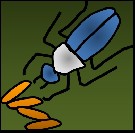While it is possible to control some kinds of insects after visible signs of infestation have appeared, stem-borer control needs to be preventive. Indeed, the larvae are very young and hardly visible when they penetrate the stems and it is too late for control when the damage begins. Given that stem-borer losses do not change a lot year after year, it is possible to establish systematic intervention procedures adapted to each agricultural and economic complex.
Chemical control
Only improved irrigated rice crops, with highly productive varieties, justify the use of insecticides against stem borers. The application of insecticides on rainfed, less-productive rice, is not cost-effective. When the farmer decides to apply an insecticide, he/she has to be sure that this operation is cost-effective and, most of all, he/she has to follow the recommendations to guarantee the efficiency of the treatments and his/her own safety. In areas at high risk of stem-borer infestation, carbofuran, diazinon or lindane at a rate of 2 kg a.i./ha can be recommended to be applied 20 days after planting to combat Diopsis spp., and 50 to 70 days after planting to combat lepidopterous stem borers.
Crop management practices
Early sowing, narrow spacing of plants and maintaining weed-free fields can minimize stem-borer infestation. It is possible to limit infestation by Chilo zacconius by synchronized planting over large areas.
Several tillage practices can interrupt the life-cycle of stem borers:
-
stubble plowing kills the caterpillars in the stalks and crop residues,
-
fallowing (interruption of cultivation),
-
destroying intermediate host plants to eliminate breeding sites,
-
flooding the rice fields after harvest.
These solutions require sufficient time, labor and adequate water control. Tillage practices and manure application favor good plant development and the resistance of the crop, but they can increase infestation at the same time.
Biological control
There are a variety of earwings, dragonflies, and spiders that feed on larvae and adult stem borers.
Among the numerous parasitoids on Sesamia spp., the braconid Cotesia (= Apanteles) sesamiae Cameron and the eulophid Pediobus furvus Gahan are the most important.
Research on biological control has just begun in Africa. Based on the inability of the indigenous natural enemies to suppress insect populations, Cotesia flavipes Cameron was imported from Asia and released in Côte d’Ivoire and Senegal against Chilo zacconius in rice, but with no lasting success. Further biological programs must be considered with caution since there is a need to know more about interactions of indigenous natural enemies before embarking on classical biological control by the introduction of parasitoids.
Varietal resistance
This is using varieties that are resistant or tolerant to insect pest damage. The following resistant O. sativa lines have been identified:
-
ITA 121 (tolerant to Diopsis spp.)
-
LAC 23, IR 4625-132-1-2, IR 2035-120-3, Colombia 1, N 21-1 (tolerant to Chilo zacconius)
-
IR 1108-3-5-2, SML 140/10, SML 140/5 X TN 1, SML 140/5 X IR 8, IR 2871-53-2, TOS 4153, B2850, BS-1-2-2, IET 5905, IR 9872-144-3-3-3 (tolerant to Maliarpha separattela)
Several promising lines that show appreciable resistance have been identified, particularly among African rices O. glaberrima. NERICA 4, an upland interspecific (O. sativa ´ O. glaberrima) shows good tolerance to stem borers. However, no commercial varieties resistant to C. zacconium and M. separatella suitable for West African lowland conditions have been released yet.
Integrated stem borer control
Integrated control aims at keeping the populations of stem borers as low as possible without disturbing the ecosystem’s stability. Integrated control views the different control measures as complementary and not as alternatives.













